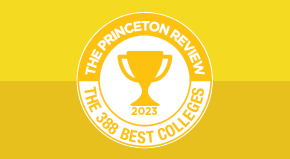
Can you identify which devices use the Internet Protocol (IP) when sending data through the Internet? Do you know what the digital divide is? The AP® Computer Science Principles exam tests topics and skills discussed in your Advanced Placement Computer Science Principles course. If you score high enough, your AP Computer Science Principles score could earn you college credit!
Check out our AP Computer Science Principles Guide for the essential information you need for the exam:
- AP Computer Science Principles Exam Overview
- Differences Between Comp Sci A and Comp Sci Principles
- Question Types
- Reference Sheet
- Scoring
- How to Prepare
What’s on the AP Computer Science Principles Exam?
The AP Computer Science Principles exam has one multiple-choice section that takes 2 hours to complete. The exam also consistent of a Create Performance Task completed outside of test time.
|
Timing |
Number of Questions |
% of Exam Score |
|
|
Section 1 |
2 hours |
70 multiple-choice questions |
70% |
|
Section 2 |
N/A |
Create Performance Task *Student created program complete outside of test time. |
30% |
AP Computer Science Principles Review: Topics
The topics of the AP Computer Science Principles Exam are grouped into five Big Ideas.
- Big Idea 1: Creative Development. Topics may include: collaboration, program functions and purpose, program design and development, and identifying and correcting errors.
- Big Idea 2: Data. Topics may include: binary numbers, data compression, extracting information from data, and using programs with data.
- Big Idea 3: Algorithms and Programming. Topics may include: variables and assignments, data abstraction, mathematical expressions, strings, Boolean expressions, conditionals, nested conditionals, iteration, developing algorithms, lists, binary search, calling procedures, developing procedures, libraries, random values, simulations, algorithmic efficiency, and undecidable problems.
- Big Idea 4: Computer Systems and Networks. Topics may include: the Internet, fault tolerance, and parallel and distributed computing.
- Big Idea 5: Impact of Computing. Topics may include: beneficial and harmful effects, digital divide, computing bias, crowdsourcing, legal and ethical concerns, and safe computing.
Check out our AP Computer Science Principles Prep book for a comprehensive content review
What’s the difference between AP Computer Science A and AP Computer Science Principles?
The AP Computer Science A course and exam focus on computing skills related to programming in Java. Students cultivate their understanding of coding through analyzing, writing, and testing code as they explore concepts like modularity, variables, and control structures.
AP Computer Science Principles provides students with a broad introduction to computer science and how it relates to other fields.
The AP Computer Science Principles course complements AP Computer Science A and focuses on the broader aspects of computing. Students learn to design and evaluate solutions and to apply computer science to solve problems through the development of algorithms and programs. They incorporate abstraction into programs and use data to discover new knowledge. Students also explain how computing innovations and computing systems including the internet work, explore the potential impacts of these innovations, and contribute to a computing culture that is collaborative and ethical.
Additionally, the AP Exams for the two courses have different formats. AP Computer Science A has one end-of-course exam with multiple-choice and free-response questions. AP Computer Science Principles includes the Create performance task, which is completed during the course, and an end-of-course multiple-choice exam.
AP Computer Science Principles Question Types
Multiple-Choice
The AP Computer Science Principles multiple-choice section contains that come in three types:
|
Question Type |
Number of Questions |
Number of Correct Answers |
|
Single-select |
57 |
1 |
|
Single-select with reading passage about computing innovation |
5 |
1 |
|
Multi-select |
8 |
2 |
Grading: This section is scored by a computer.
Creative Performance Task
The AP Computer Science Principles exam has a Create Performance Task, which is a student created program completed outside of test time. Student need to submit the following:
- program code
- video
- written response
Grading: You are award one point for completing each of the following criteria for a potential total of six points:
- Describing the overall purpose and function of the program
- Showing how your program uses data abstraction
- Explaining how complexity is managed in the program
- Demonstrating how your program uses procedural abstraction
- Using proper implementation of algorithms
- Test your program for intended functionality
The responses are scored by a committee of high school and college teachers and are graded according to a standard set at the beginning of the grading period by the chief faculty consultants.
AP Computer Science Principles Exam Reference Sheet
Test takers are provided with an Exam Reference Sheet. Because there is no designated program language for the AP Computer Science Principles course, the Exam Reference sheet is used allow student studying various languages to have one common language to work with on test day. Check out The College Board's AP Computer Science Principles Course and Exam Description for more information.
How to Interpret AP Computer Science Principles Scores
AP scores are reported from 1 to 5. Colleges are generally looking for a 4 or 5 on the AP Chemistry exam, but some may grant credit for a 3. (Check out our overview of how to earn AP credit). Each test is curved so scores vary from year to year. Here’s how students scored on the AP Computer Science Principles exam in May 2020:|
Score |
Meaning |
Percentage of Test Takers |
|
5 |
Extremely qualified |
10.9% |
|
4 |
Well qualified |
23.6% |
|
3 |
Qualified |
37.1% |
|
2 |
Possibly qualified |
19.8% |
|
1 |
No recommendation |
8.6% |
Source: College Board
How Can I Prepare?
AP classes are great, but for many students they’re not enough! For a thorough review of AP Computer Science Principles content and strategy, pick the AP prep option that works best for your goals and learning style.
Read More
Explore Colleges For You
Connect with our featured colleges to find schools that both match your interests and are looking for students like you.
Get Started on Athletic Scholarships & Recruiting!
Join athletes who were discovered, recruited & often received scholarships after connecting with NCSA's 42,000 strong network of coaches.
Best 388 Colleges
154,000 students rate everything from their professors to their campus social scene.



